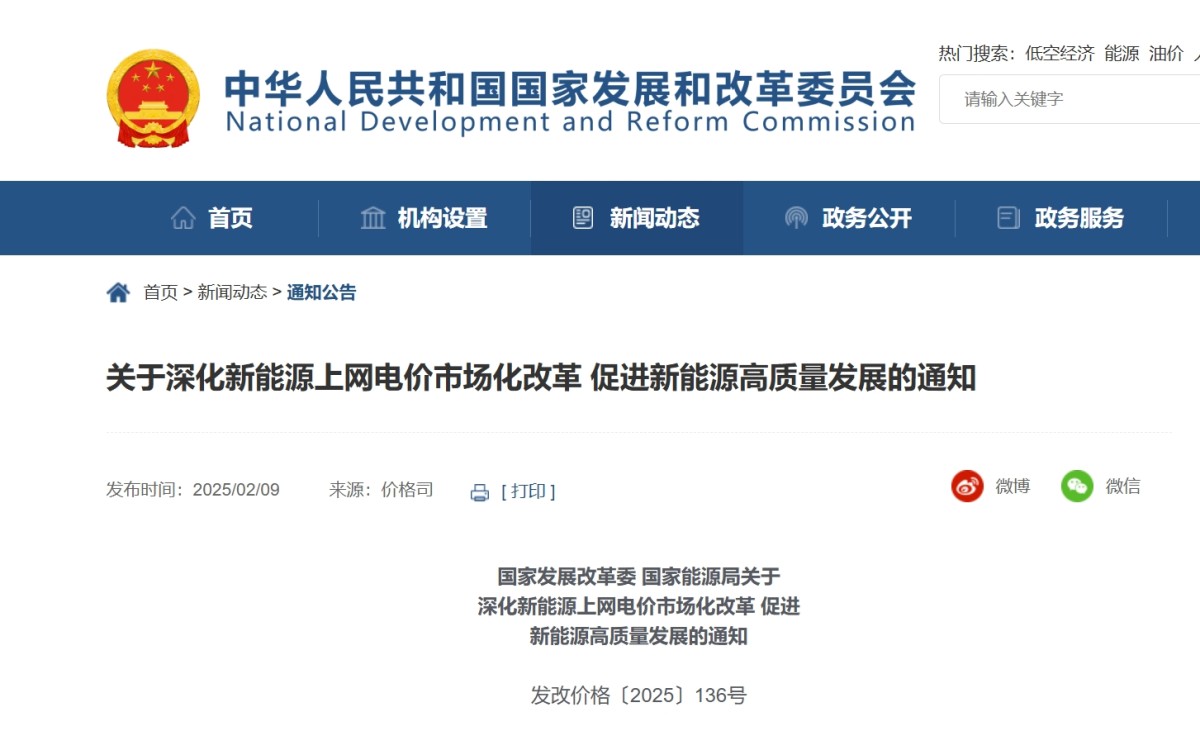News Center
—— NEWS CENTER ——
Policy demarcation: revenue model of existing and incremental projects
The Notice on Deepening the Market-oriented Reform of New Energy On-Grid Electricity Prices and Promoting High-quality Development of New Energy issued on February 9, 2025 stipulates that all existing new energy power plants put into production from June 1, 2025 will enter the power market for trading, and the electricity price will be formed through bidding, and the "bottom price + priority consumption" will be terminated. Existing new energy power plants put into production before June 1, 2025 can independently decide the proportion of electricity participating in the price difference settlement mechanism each year, but the proportion shall not exceed the level of the previous year. New energy power plants are encouraged to improve their competitiveness through equipment renewal. This policy not only avoids the cliff-like drop in the income of existing power plants due to market shocks, but also promotes the improvement of the quality and efficiency of existing assets through incentives for technological upgrades, and ultimately realizes a smooth transition from policy-driven to market-driven in the new energy industry.
The "Management Measures for the Development and Construction of Distributed Photovoltaic Power Stations" issued on January 17, 2025 stipulates that industrial and commercial distributed photovoltaic projects connected to the grid before May 1, 2025 can continue to implement the original policies, including full grid-connected mode and enjoy higher subsidized electricity prices; industrial and commercial distributed photovoltaic projects connected to the grid after May 1, 2025 are only allowed to choose self-generation and self-use or surplus power grid-connected mode.
This will change the revenue model of power stations. Existing power stations will be fully connected to the grid and have a fixed electricity price in the short term; while new power stations will generate electricity for their own use or connect surplus power to the grid, and the electricity price will be determined by the market and will fluctuate more.
If the existing power stations maintain the full grid-connected model, replacing old PV modules can improve revenue and long-term competitiveness:
The policy clearly states that in principle, all grid-connected electricity from new energy sources will enter the electricity market, and electricity prices will be formed through market transactions. Even if existing projects temporarily retain some guaranteed electricity, in the long run, the marketization ratio needs to be gradually increased, and fixed benchmark electricity price settlement cannot be maintained indefinitely.
Under market-based transactions, the volatility of photovoltaic electricity prices is much higher than the benchmark electricity price. For example, the peak photovoltaic power generation period at noon may face a low electricity price, while the evening peak electricity price is higher when it relies on energy storage or coal-fired power. Taking Shandong Province in China as an example, during the trial operation of the spot market in 2023, the photovoltaic electricity price at noon dropped to as low as 0.1 CNY/kWh, while the evening peak electricity price could reach 0.8 CNY/kWh, with a daily price difference of more than 700%.
If it continues to use inefficient PV modules and maintains the full-price grid-connected model, its revenue will face reductions in 2 ways:
On the one hand, inefficient PV modules lead to insufficient power generation. As the proportion of market-based transactions continues to expand, the price of electricity during the peak photovoltaic power generation period at noon may fall to a low point (for example, the spot market of Shandong Province in China once saw an extremely low price of 0.1 CNY/kWh);
On the other hand, as the grid consumption rules tilt towards marketization, the advantages of fixed electricity prices under the full grid-connected model disappear, and power stations need to compete with high-efficiency projects in the electricity spot market, resulting in the forced sale of surplus electricity during low-price periods (for example, the lunchtime electricity price is only 0.3-0.4 CNY/kWh). Due to the greater volatility of electricity prices, industrial and commercial electricity may be purchased at high prices (0.6-1 CNY/kWh), forming a "scissors gap" of "selling low and buying high", which ultimately accelerates the decline of profits of power stations with the marketization process.
Through replacing old PV modules in existing power plants can improve their revenue and long-term competitiveness:
If the technological transformation does not change the grid-connected time of the original project, for example, only replacement of old PV mpdules, inverter upgrade or small capacity increase (increase ≤ 30% of the registered scale) is carried out, the project will still belong to the category of existing power stations, such projects can continue to be subject to the original electricity price policy framework, including guaranteed purchases, fixed electricity prices and subsidy mechanisms. Under the fixed income model, the improvement in power generation efficiency will be directly converted into incremental revenue.
Compared with new power plants that are affected by market-based electricity price fluctuations, short-term profit stability of existing power stations is significantly superior; in the long run, the increase in power generation achieved by replacing old PV modules can enable existing projects to maintain the same competitiveness as new projects during their life cycle.
If the existing power stations are converted to the surplus power grid access mode, replacing old PV modules can increase the overall revenue:
If inefficient PV modules are still used, existing power plants will face double risks:
Insufficient power generation period: the proportion of self-use is low, and industrial and commercial electricity needs to be purchased at a high price (usually 0.6-1 CNY/kWh);
Periods of excess power generation: Excess electricity is forced to be connected to the grid during the low-price period at noon (usually 0.3-0.4 CNY/kWh), which greatly reduces profits.
Through replacing old PV modules, the existing power stations can restructure their revenue structure:
Increased proportion of self-use: power generation covers more self-use needs, reducing high-priced external power purchases;
Compressing the proportion of surplus electricity: The proportion of on-grid electricity is reduced to avoid low-price selling at noon.
The profit per kilowatt-hour has doubled: the price of electricity for self-use is 2-3 times that of the surplus electricity connected to the grid. After the replacement of PV modules, the total profit has increased instead of decreased. Take a 10MW industrial and commercial power station as an example:
Before replacement of PV mdoules: annual power generation: 12 million kWh, 60% for self-use (7.2 million kWh), 40% for surplus (4.8 million kWh), annual income = 7.2 million kWh × 0.8 CNY (self-use electricity price) + 4.8 million kWh × 0.35 CNY (surplus electricity price) = 7.44 million CNY.
After the repalcement of PV modules: the efficiency increased by 20%, the annual power generation was 14.4 million kWh, 80% for self-use (11.52 million kWh), and the surplus was 20% (2.88 million kWh). The annual income = 11.52 million kWh × 0.8 CNY + 2.88 million kWh × 0.35 CNY = 10.224 million CNY, with a profit increase of 37%.

About RESOLAR
Shanghai RESOLAR Energy Technology Co., Ltd. is committed to becoming a recycled material photovoltaic group with deep decarbonization. RESOLAR focuses on technological innovation and builds a world-leading solution for component recycling, impurity removal of damaged cells, recycled silicon materials and cells, and cascaded utilization of components. With professional technology and services, we help customers realize the recycling and reuse of waste photovoltaic resources, and make positive contributions to the development of environmental protection and new energy industries. For more detailed information, you can browse the official website: www.resolartech.com .
Latest developments/news
Contact information
Service Hotline: 13585742918 (Monday to Friday 9:00-18:00)
Enterprise email: ps@resolartech.com (Reply within 48 hours after receiving the email consultation!)
Company Address: Building 8, No. 1528, Wangxu East Road, Fengjing Town, Jinshan District, Shanghai (Caohejing Fengjing Park)



